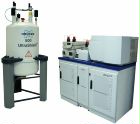When the chemistry department moves into the new science center
summer 2004, they won't be taking its 13-year-old NMR along. A
nuclear magnetic resonance spectrometer (NMR) is a versatile, yet
fundamental piece of equipment for chemists. Hamilton College,
under the leadership of Robin Kinnel, the Silas D. Childs Professor of
Chemistry, has been awarded a $238,356 grant from the National Science
Foundation's Major Research Instrumentation (MRI) program to support
the purchase of a new 500 Mhz NMR.
Kinnel said the timing of the grant and new acquisitions is good because it cost somewhere between $10,000 and 15,000 "power down" the old machine for a safe move and then bring it back on-line.
The NMR helps chemists unravel the structures of organic molecules and is used to study the physical, chemical and biological properties of a wide variety of compounds. As a result, NMR spectroscopy finds applications in several areas of science. "It's based on the same phenomenon as the Magnetic Resonance Imaging (MRI) that physicians use to produce images of the interior of the body," Kinnel explained. "It is also used to analyze the physical chemistry of molecular shapes and interactions of protons in space."
Hamilton will be one of the first liberal arts colleges to acquire this particular NMR model. A "problem" that arose because of the grant that allowed for the purchase of this bigger and more powerful machine was that not enough space was allocated for it in the new science center. Fortunately, the problem was solved after Kinnel contacted Douglas A. Weldon, Stone Professor of Psychology and science curriculum and facilities coordinator. Weldon said he worked with the contractors and architects who quickly found the extra space and ensured the necessary ceiling height. Kinnel, who was involved in an earlier renovation of the science facilities, said, "I've been really impressed with not only the design but with the attention to detail. The architects have the building planned down to the nail."

This will be the fourth NMR that the College has acquired, and the third that has been procured with the assistance of grant funds from the National Science Foundation. "We were operating with diminished capacity with the old machine," said Kinnel, "Not only were there persistent maintenance issues, but our students were not always able to do what they need to do and faculty were not able to complete all of their research projects because the old NMR simply didn't have the analytical ability." The new machine will provide the improved sensitivity and resolution needed to enhance the research productivity of the faculty members involved in the project. Other faculty members who will utilize the NMR and who assisted in the NSF proposal are Herman Lehman, associate professor of biology, Ian Rosenstein, associate professor of chemistry, and George Shields, Winslow professor of chemistry.
Kinnel said the computational chemistry research conducted on Hamilton's "super computer" (http://mars.chem.hamilton.edu/index.html) has an applied research component that will possible to do with the new NMR. It will also provide undergraduate researchers with easy access to two-dimensional experiments. Traditionally, these types of experiments have helped undergraduate researchers develop a better appreciation the power of the NMR at an earlier stage in their education. In addition, the group felt that a more powerful instrument would allow for the development new interfaces between researchers in the science division.
"The award (for the NMR) was particularly gratifying because it not only allowed us to move forward with the acquisition of the new NMR, but it also was an endorsement of our research projects. It was energizing," Kinnel said. Moreover, the group felt a sense of satisfaction; they were able to help equip the new science facility without having to rely entirely on institutional funding. "Clearly, this award would not have been made without institutional support," Kinnel said, noting that the award will be matched with nearly $300,000 from an endowed fund designed to assist the College replace outdated equipment.
Other faculty members are already pursuing additional equipment
grants. Weldon is quick to point out, "The sciences are really
well-equipped already. The architecture of the new facility will
improve access and visibility." Examples of equipment funding already
secured include the new Bioinformatics center, a networked classroom
for polarized light microscopy and a florescent microscope.
Posted February 3, 2004
